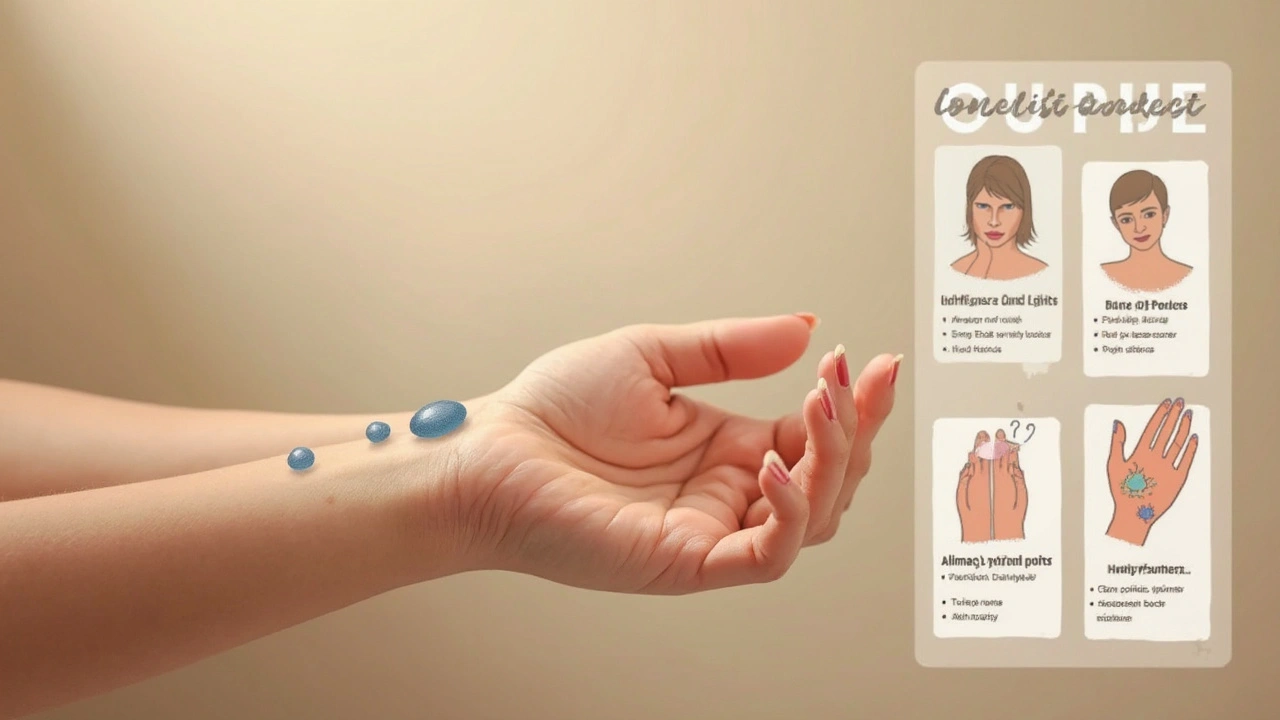Sore neck after a long day? Can't shut off your brain at night? A lot of people swear by acupressure as a fix for these everyday aches and stresses. No need for needles or fancy equipment—all you really need are your own hands and some basic know-how.
At its core, acupressure is about pressing specific spots on your body to trigger natural healing. These spots, sometimes called pressure points, work kind of like little reset buttons. You can find them all over, from your temples to your feet. People have been working with these points for thousands of years, but you don't need a history lesson to start using them for yourself.
Ever rub your temples when you've got a headache? Or press the spot between your thumb and forefinger to ease tension? You’re already doing a bit of acupressure, even if you didn't know it. Knowing which spots to press—and how much pressure to use—can make a difference for sleep, stress, and even some types of pain relief.
- What Is Acupressure Anyway?
- How Pressure Points Really Work
- What Acupressure Can (and Can't) Help With
- DIY Acupressure: Tips for Beginners
- Safety, Myths, and When to Ask for Help
What Is Acupressure Anyway?
So what exactly is acupressure? Think of it as an ancient self-care hack from China, older than sliced bread—actually, way older. It’s a practice where you use your fingers, thumbs, or even a simple tool to press on certain parts of your body, known as pressure points. The goal? Unclog stagnant energy (what traditional Chinese medicine calls "qi," pronounced "chee") and get your body working at its best.
Acupressure is like acupuncture’s needle-free cousin. Both target the same network of points that connect over invisible lines called meridians. But with acupressure, you stick to pressing, not poking. This makes it less intimidating and something you can actually do at home or even at your work desk.
Here’s what makes acupressure special:
- Self-care made easy: You can use acupressure anywhere—no doctor’s office needed.
- Completely non-invasive: You’re not breaking the skin, just using gentle pressure.
- Science is catching up: Some recent studies show pressure points can impact pain levels and even stress, though more research is still needed.
To give you a sense of where acupressure stands among other therapies, check this out:
| Therapy | Tools Required | DIY Friendly? |
|---|---|---|
| Acupuncture | Needles | No |
| Acupressure | Fingers/Hands | Yes |
| Massage | Hands/Oils | Sort of (hard for full body) |
Most people turn to acupressure for help with pain relief, sleep, tension, and sometimes even nausea. It isn’t a "miracle cure"—nothing is—but it’s surprisingly handy for quick fixes and daily care. The best part: you control it, so you don’t have to make any appointments or empty your wallet.
How Pressure Points Really Work
So what's going on under the skin when you press a pressure point? Here’s the deal. Traditional Chinese Medicine explains these points in terms of energy, or "qi” (pronounced “chee”), which flows through what they call meridians—kind of like invisible highways all over your body. Blockages on these highways are thought to mess with your health, and pressing the right spots keeps things moving.
Modern science has a different angle. Pressing on some of these points can trigger your nervous system, telling your brain to release feel-good chemicals like endorphins. Blood flow can also increase in the area, and muscles often start to relax. When it comes to pain and stress relief, this combo is actually pretty helpful for a lot of folks.
- Some pressure points are just over major nerves or muscles—so pressing them sends a clear signal up to your brain.
- Other points can affect blood circulation, helping break the cycle of tension and pain.
- Boosts in endorphins help explain why some people feel almost immediate relief or a mood lift.
For example, one pressure point called Large Intestine 4—right in the web between your thumb and index finger—has been studied for headaches and stress. In one controlled trial in 2022, people who pressed this point for five minutes felt a noticeable drop in headache intensity compared to those who didn’t.
Here’s a quick look at what happens physiologically when you use acupressure on the body:
| Action | Body Response |
|---|---|
| Firm pressure on a point | Activates local nerves, sends signals to brain |
| Triggering a sore spot | Muscle relaxes, blood flow increases |
| Sustained pressing (1-2 min) | Endorphins released, pain perception drops |
While acupressure won’t replace a doctor for serious stuff, there’s enough going on in the body to explain why these techniques feel good for so many people. The key is knowing where to press, how much pressure to use, and how long to keep it up.

What Acupressure Can (and Can't) Help With
So, what real results can you expect from acupressure? Let’s cut through the hype and stick to facts from solid studies and a ton of user experience.
Research shows acupressure may help with some common issues, but it’s not a one-stop cure-all. Here’s where it often makes a noticeable difference:
- Pain Relief: Headaches, neck, and lower back pain often respond well to pressure point work. One study found people using acupressure for chronic back pain saw pain drop by about 40% in six weeks.
- Stress and Anxiety: It’s known for its relaxing effects. Some hospitals offer acupressure as part of cancer care to calm nerves before treatments.
- Bugging Nausea: Motion sickness, morning sickness, and even chemo-related nausea sometimes ease up with the right wrist points.
- Sleep Struggles: People with mild insomnia often use self-acupressure routines before bed and report falling asleep faster.
| Condition | Reported Benefit |
|---|---|
| Chronic Headache | ↓ Frequency & intensity |
| Nausea (Chemo/Motion) | ↓ Symptoms by up to 50% |
| Stress/Anxiety | ↑ Relaxation, lower heart rate |
| Lower Back Pain | ↓ Pain levels about 40% |
Here’s what acupressure probably can’t do:
- Cure serious diseases or infections—don't ditch your doctor or meds.
- Fix bone or joint injuries—broken bones and sprains need medical help.
- Replace good sleep, nutrition, or regular check-ups. It’s a helpful add-on, not a life substitute.
Bottom line: try acupressure for things like headaches, nerves, or nausea. But if you have anything major going on, always check in with a healthcare pro first. Treat it as backup for everyday issues—not magic.
DIY Acupressure: Tips for Beginners
Trying acupressure at home doesn’t have to be complicated. You don’t need special gear—just your hands and maybe a timer. The key is knowing where to press, how long, and how hard.
Here’s a super simple way to get started:
- Find the right spot. The “LI4” point—between your thumb and index finger—is great for headaches and general stress. The “PC6” point, a couple of finger-widths below the wrist crease, is known to help with nausea and motion sickness. And the “GV20” point, right on the top of your head, is often used for calming anxiety and boosting mood.
- Use the right pressure. You’re aiming for firm but comfortable pressure. If it hurts badly or leaves marks, you’re probably pressing too hard. Most people find that holding steady pressure with a thumb or fingertip feels best.
- Stick to a routine. Hold each spot for about 30 seconds to 2 minutes. Breathe deeply as you go. Repeat a few times a day, or whenever you’re feeling off.
Here’s a quick look at a few beginner-friendly pressure points and what they’re used for:
| Point Name | Location | Common Use |
|---|---|---|
| LI4 (Hegu) | Between thumb and index finger | Headaches, general pain, stress |
| PC6 (Neiguan) | Inside of wrist, a few cm below crease | Nausea, anxiety, tummy troubles |
| GV20 (Baihui) | Top of the head | Fatigue, low mood, clarity |
Here are a few more solid tips for acupressure newbies:
- Don’t rush. Give each spot a little time. If your hand starts cramping up, give it a break.
- Listen to your body. If you feel sharp pain, dizziness, or weird side effects, stop right away.
- Stay consistent. Like most self-care routines, results show up when you practice regularly.
- Wash your hands. Sounds obvious, but it keeps things clean—especially if you’re pressing around the face.
If you’re ever in doubt about which spots are safe, double-check with a pro or look up diagrams from trusted sources. When done right, acupressure can be easy, safe, and surprisingly effective as a daily habit.

Safety, Myths, and When to Ask for Help
Let’s be real—acupressure looks pretty harmless, but there’s more to it than randomly poking yourself. Most folks can safely try acupressure at home, especially on common spots like hands, feet, or shoulders. But there are some cases where you want to play it safe. If you’re pregnant, skip pressure points around the abdomen and ankles (some points are thought to trigger labor). If you have a serious health condition like heart disease, cancer, or a bleeding disorder, check with your doctor before rolling up your sleeves.
There are a lot of claims out there—let’s sort fact from fiction. No, acupressure isn’t magic, and it definitely isn’t a replacement for meds if you have a major illness. It won’t shrink a tumor or heal a broken bone. But, research suggests it may help with everyday stuff like stress, headaches, or mild aches. A review in 2023 found that people with chronic pain felt real relief from regular self-applied pressure points—but not everyone gets the same results.
- If a spot feels sharp, numb, or really uncomfortable, stop pressing.
- Don’t use acupressure over open wounds, infected areas, or recent injuries.
- If you feel faint, dizzy, or suddenly worse, go easy and check in with a professional.
It’s always smart to get help if something doesn’t feel right. Here’s when to reach out:
- Your pain keeps getting worse, or won’t go away.
- You have a health condition and aren’t sure where to press.
- You want to use acupressure for a specific problem, like nausea during pregnancy or managing migraines long-term.
Curious about common myths and facts? Check out this table:
| Myth | Reality |
|---|---|
| Acupressure cures major diseases. | It helps with pain relief and stress, but it’s not a cure-all. |
| More pressure = better results. | Gentle, steady pressure is usually enough. Too much can cause bruising. |
| You need a pro every time. | Self-care is totally possible for most basic uses, like relaxing or easing a headache. |
So, know your limits, listen to your body, and don’t hesitate to check with a pro if you ever feel unsure. Making acupressure part of your regular self-care can be handy, as long as you use some basic common sense.
